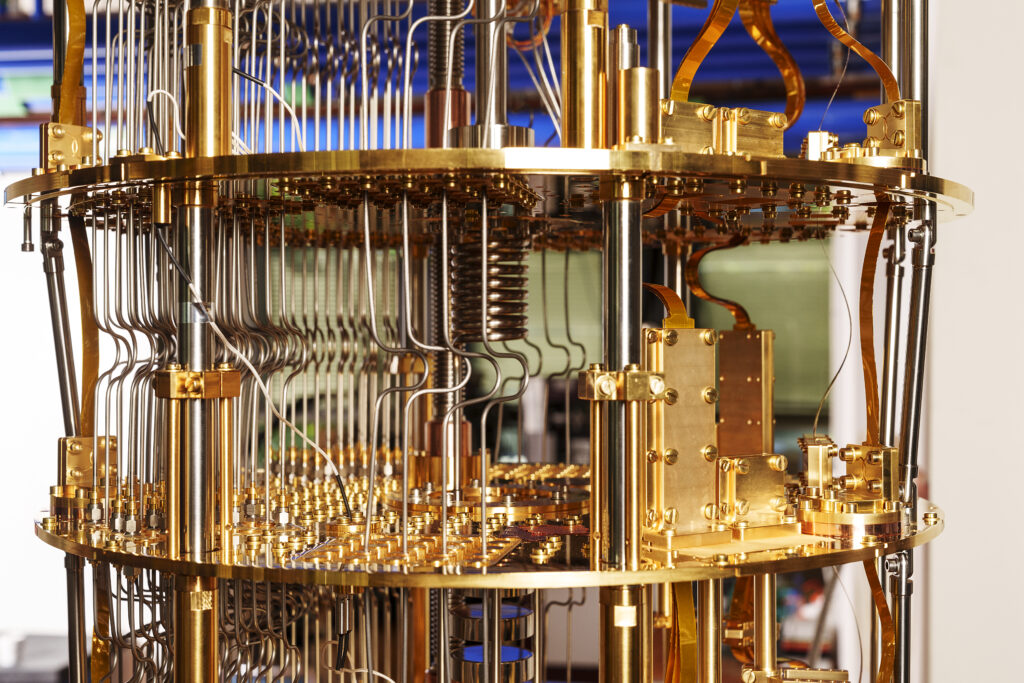10.06.2025Quantum Computing
Spin qubits ride the wave

Researchers at QuTech have successfully transported a single electron over an extended distance while preserving its spin. The displacement was achieved by moving a quantum dot, containing the electron, through a Si/SiGe heterostructure using a traveling wave potential. This achievement could enable coherent spin shuttling both within and between qubit arrays – an important step towards scalable quantum processors. The researchers published their results in Nature Nanotechnology.
Qubit connectivity, the efficiency with which qubits can interact and share information with each other, is a major influential factor in the computational power and fault-tolerance of future large-scale quantum processors. To increase the connectivity between qubits remaining in place, researchers focus on improving qubit-qubit interactions at larger distances. An alternative approach would be to physically relocate qubits on a chip, termed shuttling, thereby increasing the number of potential interactions. For semiconductor spin qubits, several studies have already been performed to investigate spin-coherent shuttling of individual electrons. However, high-fidelity transport over long distances – where almost all electrons maintain their spin when shuttling large amounts – remains to be demonstrated.
Now, researchers at QuTech led by Lieven Vandersypen reported the high-fidelity displacement of an electron spin in an isotopically purified silicon/silicongermanium (Si/SiGe) heterostructure using electric gate voltages. They used a traveling wave potential to displace a quantum dot holding the electron as a whole and reported a significant increase in spin coherence. Using this method, the electron was able to ride the wave over a large effective distance of 10 micrometres in under 200 nanoseconds with an average fidelity of 99.5%.

Illustration of spin shuttling in a silicon quantum dot array. (a) In conventional static architectures, electron spins are confined to fixed quantum dots. An electron can hop from one dot to the next by adjusting the energy difference (detuning) between neighboring dots, in a process known as bucket-brigade shuttling. (b) The electron is transported by a traveling wave potential, or conveyor, created by sinusoidal voltages on the gate electrodes. It ensures the electron remains securely trapped in a moving potential well throughout its journey. In this work, a single spin is coherently transported back-and-forth over 10 micrometer in total, taking under 200 ns and preserving the state with high fidelity.
Moving qubits
Nowadays, most qubits on a quantum processor are stuck in place, similar to transistors in current computers. However, qubits and transistors differ in that the latter uses electric signals to carry around information. “In a quantum chip, the qubits themselves contain the information and need to interact with their neighbours to allow for quantum computing”, Vandersypen explains. “Being able to move these qubits around in order to bring one qubit close to another situated somewhere else in a qubit array could therefore open up new possibilities of quantum computing.”
Fault-tolerant quantum computing will likely require millions of qubits. One of the approaches to realize these large-scale quantum processors is to build networks of spatially separated qubit arrays. Semiconductor spin qubits are an attractive choice for these densely packed arrays, as they are compatible with semiconductor fabrication techniques. Moving spin qubits around between these arrays could significantly improve the efficacy of the network. Vandersypen: “Placing spin qubits closely together allows them to ‘sense’ each other and entangle. If they are carefully pulled apart again, the entanglement remains intact. To enable computation and connectivity between qubit arrays, it is essential that the spin of the entangled qubit remains coherent when shuttling them around.”
Transporting waves
The researchers tested two distinct techniques to shuttle single electrons and study their respective spin coherence fidelity. The first technique, bucket-brigade shuttling, transported the electron along five static quantum dots, propelled by gate voltage pulses. “This can be envisioned as people lining up and passing along buckets of water to extinguish a fire”, shared first author Maxim De Smet explains. “Here, the people symbolize the quantum dots and the buckets are electrons moved from dot to dot. Using this technique, we studied whether the spin state of the electron remained as intact as when keeping the electron in place. Though it worked quite well, the fidelity was not good enough for serious computing.”
The second technique, referred to as conveyor-mode shuttling, uses a traveling wave potential to form moving quantum dots, carrying the electron along. For this, the researchers applied a sinusoidal voltage on the electrodes in their device which made the electron ride along the traveling wave. De Smet: “Following the previous analogy, a single person now walks from the river to the fire carrying the bucket themselves and if they are careful loses a lot less water along the way. We demonstrated that this technique allowed us to transport the spin state of the electron both fast and with a higher fidelity.”
Future research
As a next step, the researchers are now focusing on using traveling wave potentials to bring two electrons together. Here, the goal is to identify whether two spin qubits become entangled when brought close together and remain coherent when pulled apart again using the conveyor-mode. If that would be the case, these results could guide future efforts to design and implement networks of spin qubits on a chip for large-scale fault-tolerant quantum processors.



